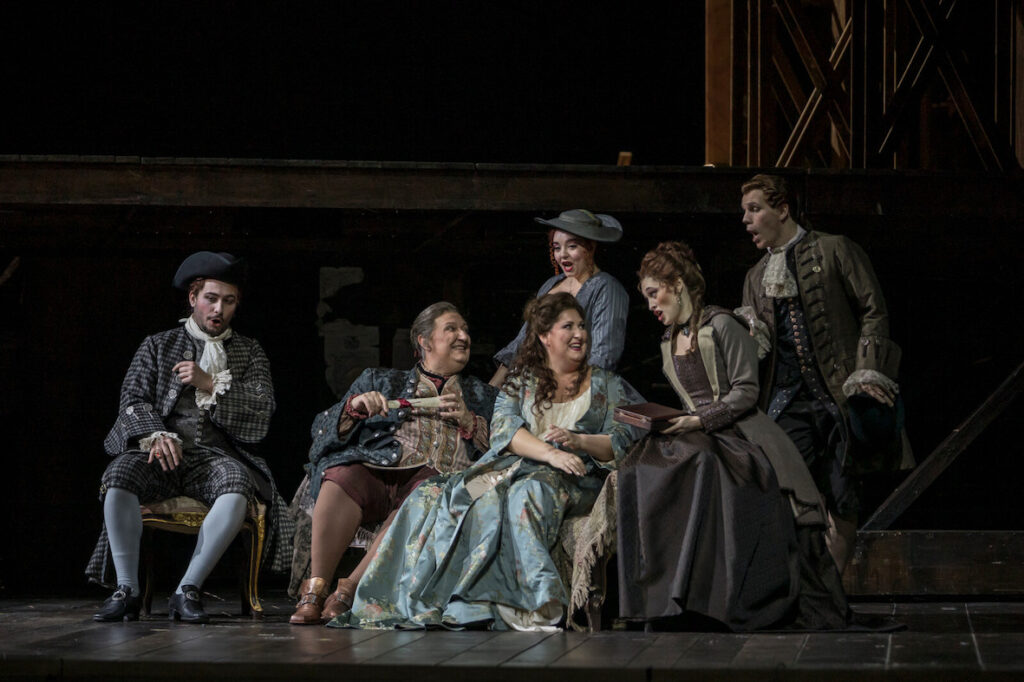The one by Francesco Cilea. There are several others by forgotten composers. This one sits uneasily in the verismo category given its hyper contrived plot and its historical setting.
Leading ladies have long been a theatrical topos. Victorian Sardou’s play Tosca premiered in 1887 with famed French actress Sarah Bernhardt as Tosca. The great Italian actress Eleanora Duse ended her romantic relationship with Italian poet and tragedian Gabriele D’Annunzio in 1898 when he gave the leading role in his La Città Morta to Sarah Bernhardt (la “Duse,” as Eleanora was called, had had a relationship with Arrigo Boito [Verdi’s librettist] as well — FYI).
Famed French dramatist Eugène Scribe indulged himself in the diva topos with his 1849 play Adrienne Lecouvreur, the source of Cilea’s opera. Both Scribe and Sardou were proponents of “well-made” plays, these had simple, compelling narratives with quick resolution. Voilà! Such is, in principle, Cilea’s 1902 Adriana Lecouvreur, though its operatic narrative became hopelessly complicated.

There was once a real Adrienne Lecouvreur, an actress of great fame in the Comédie-Francaise troupe. She died in 1730, rumored to have been poisoned, victim of a nasty amorous intrigue, by the Countess of Bouillon. Scribe’s play and Cilea’s opera imagine this intrigue replete with a dose of backstage lore and hints of obscure, early 18th century politics.
Tragedian D’Annunzio loved Cilea’s Adriana Lecouvreur, and wanted Cilea to make an opera of his 1901 tragedy Francesca da Rimini [Francesca was murdered by her husband]. The original champion of operatic verismo, publisher Edoardo Sonzogno however owned the rights to D’Annunzio’s play, and insisted that Riccardo Zandonai render it operatically. Bereft of this drama, perfectly matched to his style, Cilea has but two operas in the repertory, L’arlesiana and Adriana Lecouvreur.
Divas, seemingly, are considered essential to Cilea’s Adriana Lecouvreur. London’s Royal Opera engaged Romanian diva Angela Gheorghiu for its 2010 production, directed by David McVicar, designed by Charles Edwards. The production then came to the Opéra Bastille in 2015, again with Mme. Gheorghiu. The production moved to Vienna in 2017 and then on to New York’s Met in 2018, both with Russian diva Anna Netrebko. Just now it was mounted once again in Paris for seven performances, again with Mme. Netrebko, though she sang but the first four. Her real-life husband, Azerbaïdjanian tenor Yusuf Eyvazov was Adriana’s erstwhile lover Maurizio (illegitimate son of the king of Poland).
The final three performances were sung by Italian soprano Anna Pirozzi, long on the world’s major stages, and splendid Italian tenor Giorgio Berrugi. I attended the final performance. (See lead photo).
Sopranos with mature careers like Cilea’s Adriana role because it does not lie too high, and offers myriad opportunity to be a diva, vocally and histrionically. Its three arias are blockbusters, there are three intense duets, plus two nasty show-downs. The death scene is drawn out, with grandly ironic, quite histrionic pathos. Tenors like Maurizio because he offers them great opportunity to show off their spinto voices in its three blockbuster, though mercifully brief arias. Maurizio too has three intense duets.

Not to mention the Princess of Bouillon, Adriana’s rival for the affections of Maurizio, who has the spectacular second act aria “Acerba voluttà…O vagabonda stella” plus two dramatic shouting matches with Adriana.
Well-made plays made into well-made opera librettos have the advantage of finding immediate placement for emotive elaboration. Such is Adriana Lecouvreur’s libretto. The opera is essentially a numbers opera, i.e. a succession of set pieces — the emotive elaborations are far more important than a coherent story-line. That of Adriana Lecouvreur is famously obtuse, allowing its multitude of showcase pieces.
The David McVicar production is conceived for the world’s biggest opera houses. Charles Edwards, a frequent McVicar collaborator, obliges with a massive set that is essentially the recreation of an elaborate 18th century, Rococo theater stage and backstage. McVicar, well known for his stagings of operas with heavily political overtones, wishes to evoke the political and social failures of the epoch in this Adriana, failures that he believes emerge succinctly through, and because of the lavish elegance of the period set and costumes of this production.
Be that as it may.
Perhaps someday there will emerge a production of Adriana Lecouvreur that reveals its roots in the basic, simple tenets of the verismo that flourished in Italy in the waning years of the 19th century. A production that, refreshingly, does not succumb to the opera’s diva worship status, with the complementary grand opera trappings that divas are perceived to require. A production that reveals the emotionally frank, naturalistic world that this unfortunate-in-love, 18th century revolutionary actress deserves.
Michael Milenski
Adriana Lecouvreur: Anna Pirozzi; Maurizio: Giorgio Berrugi; Princess of Bouillon: Clémentine Margaine; Michonnet: Ambrogio Maestri; Prince of Bouillon: Sava Vemić; L’abate di Chazeuil: Leonardo Cortellazzi. Orchestra and chorus of the Opéra national de Paris. Conductor: Jader Bignamini; Mise en scène: David McVicar; Stage Director: Justin Way; Set Design: Charles Edwards; Costumes: Brigitte Reiffenstuel; Lighting: Adam Silverman. Opéra Bastille, Paris France, February 7, 2024. All photos copyright Sébastien Mathé / Opéra national de Paris.